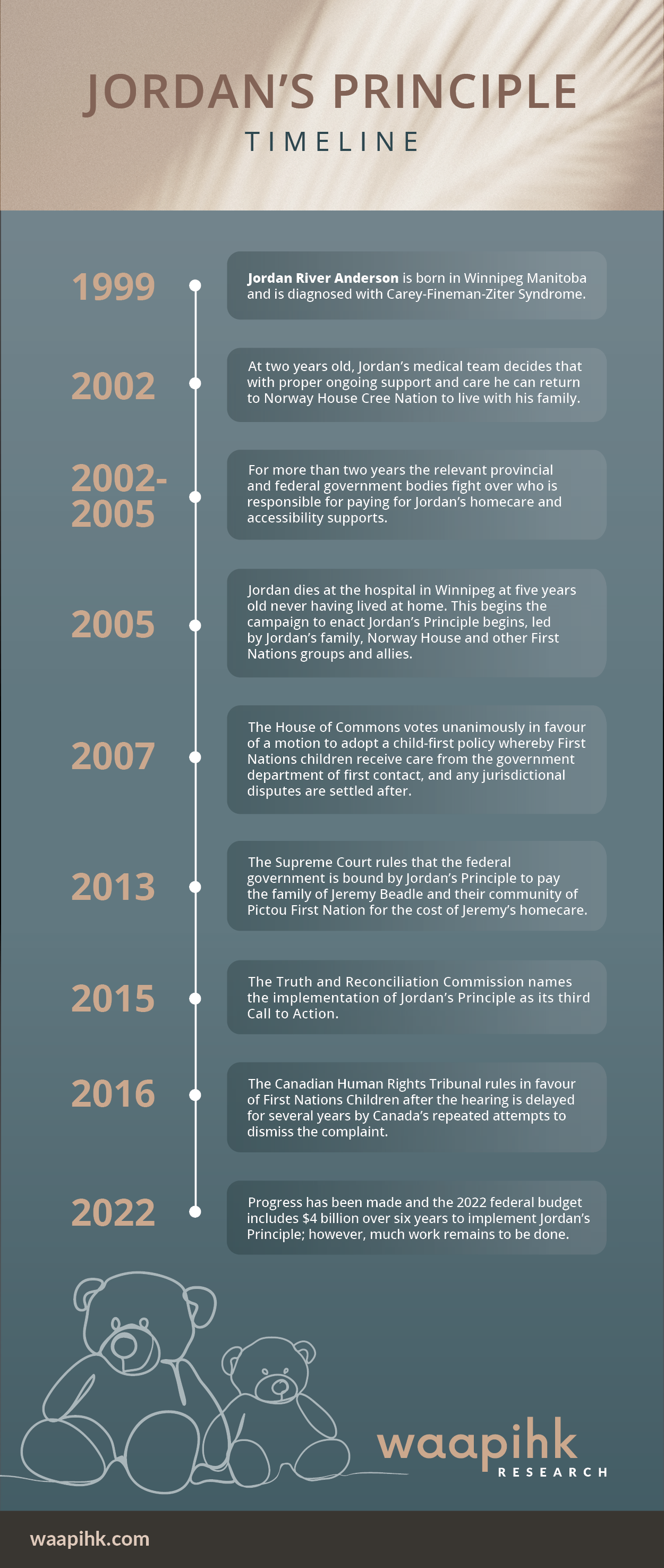What is Jordan’s Principle?
Named in honour of Jordan River Anderson, Jordan’s Principle describes Canada’s legal obligation to ensure First Nations children receive necessary services when required. It mandates that whichever government agency is first contacted to provide care for a First Nations child must do so, postponing any jurisdictional disputes between governments for later resolution. Advocacy for this principle was led by First Nations communities, including Norway House and Pinaymootang in Manitoba, Pictou Landing in Nova Scotia, along with child advocates, medical professionals, and politicians. In 2007, it was formally proposed in a bill and received unanimous support in the House of Commons, making it law.

Notably, Jordan’s Principle is available to all First Nations children wherever they live, ‘on’ or ‘off’ reserve, and applies to a wide range of products, services, and supports. Since the motion was passed, the Canadian Human Rights Tribunal (CHRT) determined that the government must implement Jordan’s Principle in the child’s best interests and on the basis of substantive equality. The First Nations Child and Family Caring Society (FNCFCS) notes that achieving substantive equality means considering the impacts of discrimination, social inequity, and the history of colonialism, which may lead First Nations children to require “services and supports above the ‘normal standard’.” Implementing Jordan’s Principle in the best interest of the child means making decisions without regard to “government interests like budget cycles, policy questions, or administrative case conferencing.”
Who was Jordan River Anderson?
Jordan River Anderson was a First Nations child born in 1999 in Winnipeg, Manitoba, to a family from Norway House Cree Nation, a First Nations community located 500km north of Winnipeg. Jordan was born with a rare genetic muscular disorder that required him to remain in the hospital for ongoing care. After two years, it was determined that Jordan could return home to live with his family, given the appropriate support. However, the provincial and federal governments could not agree on who would cover the necessary medical expenses for Jordan’s home care. Tragically, as the dispute continued, Jordan died in 2005 at the age of five, having spent his entire life in the hospital.
Healthcare for First Nations: A Pattern of Fragmentation
Jordan’s situation is not unique. First Nations healthcare is provided through a blend of federal and provincial departments, with jurisdictional gaps and disputes frequently creating barriers to care. According to the 1966 Medical Care Act, the provinces and territories are responsible for administering healthcare services that are universal, comprehensive, publicly administered, and portable.
However, healthcare for First Nations is complicated by the division of responsibilities outlined in the Indian Act, 1876 and the Treaty relationships between Canada and First Nations. This ambiguity regarding who is responsible for funding and delivering healthcare to First Nations has resulted in many First Nations individuals, particularly those living on-reserve and in remote locations, being underserved. Children and individuals with special needs, such as Jordan, have been particularly vulnerable to underfunded services, bureaucratic barriers, and gaps in care. As a result, some have been compelled to leave their communities and even enter the foster care system to receive the necessary care in urban areas.
Has Jordan’s Principle Enabled Greater Healthcare Access for Children?
Unfortunately, funding for Jordan’s Principle has never been sufficient to address existing needs. In fact, for almost a decade after its passage, implementation was so restrictive that the First Nations Child and Family Caring Society and others questioned whether Jordan’s own care would have been approved. In 2007, the Society and the Assembly of First Nations (AFN) named the federal government’s failure to live up to the principle in a complaint to the Canadian Human Rights Tribunal (CHRT). Maurine Beadle, a woman from Pictou Landing First Nations in Nova Scotia, also took her case to the Federal Court of Canada after being denied home care for her son, Jeremy. In both instances, the government was determined to have failed to implement Jordan’s Principle in the spirit it was intended. The CHRT decision took over 9 years due to the government’s attempts to dismiss and delay the case. The 2016 CHRT ruling affirmed that Jordan’s Principle is legally binding and must be implemented in its full meaning and scope.

Further CHRT decisions have been made since 2016 to expand access and help realize substantive equality. With increases in Jordan’s Principle spending have come concerns that the purpose of the principle should be defined in a clear and limited way to reduce backlogs and ensure expedient funding. However, restricting access to Jordan’s Principle can be at odds with the requirements of substantive equality.
Moreover, as important as Jordan’s Principle is, it is not intended to replace existing programs, only to supplement them. Services remain scarce in northern and remote communities, and receiving care often requires travelling long distances to urban centres. The rapid rollout of Jordan’s Principle and the need for program staff to adapt practices to CHRT decisions has resulted in administrative inefficiencies that lead to slow and inconsistent service provision.
For more information on Jordan’s Principle and the fight to implement it, visit jordansprinciple.ca.
Information on eligibility and how to apply is available through the Indigenous Services Canada website.

